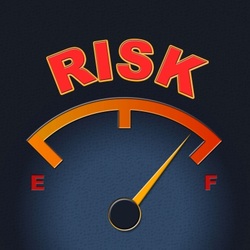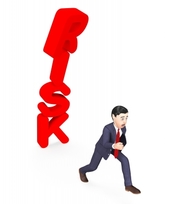"Before diving into a construction project understand the risks. What's lying in wait to bite unsuspecting contractors?" I’ve often had project managers and contractors say to me that they need to add contingency into their construction schedules because things always go wrong on construction projects. There’s bad weather, the client will delay the project, equipment will break down, we won’t achieve our quoted rates of production, etc. But how much time - do they know? Then, there are other contractors who are fearless (maybe stupid?) and are convinced that nothing will go wrong and the project is simple. They blindly rush in with their price, hoping for the best, then blame bad luck when things don’t work out as expected. Are the project risks real or imagined? "We need to understand what the real risks are and not let out imagination create problems where there aren’t." Have you been alone in a dark empty house? As the house cools after a hot day there are creaks and other strange noises. Could it be an intruder? Tap, tap at the windows, is that the windows rattling in the wind or someone trying to gain access? Scratch, scratch, could that be tree branches scraping the side of the house or a ghost scratching to get in? Maybe it’s just the neighbour’s cat looking for a warm bed? Scratch, creek, tap, scratch, creak, tap. Your imagination can play all kinds of tricks on you. You feel the adrenalin rising – flight or fight? Of course sometimes there are real dangers of walking through a dark empty house – you could trip and fall down the stairs, so using a torch or turning the lights on would be a good precaution. Also, you wouldn’t wander alone through a derelict house in a bad neighbourhood because you may just bump into someone high on drugs who could resent being disturbed. We need to understand what the real risks are and not let out imagination create problems where there aren’t. So it is when we price construction projects. Sometimes we can imagine all kinds of perils and dangers. In fact, construction projects seem fraught with danger. Tap, creak, scratch! What if it rains, the client doesn’t pay, there are labour problems, we can’t get materials, the information is late, equipment breaks down or things don’t go as planned? Well I have news for you, if you don’t already know it - in construction things seldom go exactly as planned. You can Expect the unexpected in construction "If the risks of doing the project are too big for your company, walk away" It’s good to be cautious. It’s good to feel that fear go through your body when you price a project. Feel the adrenalin flow and your senses become more aware. Fight or flight? To be honest, there are some projects where flight is the best course of action. No matter how hard you’ve worked on your price, no matter how much you want the project, if the risks of doing the project are too big for your company, walk away. You wouldn’t walk into that derelict building alone in a bad neighbourhood, so why do contractors take stupid risks and take on risky projects. Should contractors price every project? But as in that empty dark house our imaginations can run wild imagining all kinds of risks and dramas that don’t exist. Tap, creak, scratch – who is there? If we take all these imaginary risks, real and otherwise, into account we wouldn’t submit a price for any project. In fact just give up construction. How do we treat risk on our construction projects?
"A list of the risks focuses the mind on potential problems" I hear some of you say this is far too complicated for all my projects. Well for smaller projects maybe you don’t have to go into as much detail. But at least write down all the risks as this at least focuses your mind on them. Note down whether the risk is likely to happen – yes, no, maybe. Then note the consequences – acceptable, possible problem, disastrous. There, it’s in black and white and didn’t take that long. We now have a list of all our perceived risks and have allocated a possibility of the risk eventuating and the possible cost impact of the risk event if it should eventuate. What now? Dealing with construction risks"Construction risks can be managed in several ways" We can deal with risks in a number of ways:
"There are some project risks contractors can’t control"
"Don’t be too proud, or too stubborn to walk away from a risky construction project"
What happens now? Manage risks continually through the construction projectMany estimators do the right thing and create a risk schedule while pricing the project, but then it’s forgotten in the file somewhere. The estimator has implemented risk strategies, transferring risks to the customer, adding costs to cover risks or adding mitigating measures, but during bid negotiations the risk schedule is forgotten. Over eager managers in the excitement of negotiating the project award forget about the risk schedule (maybe they don’t know it exists or don’t understand it) and they concede to the customer’s requests to remove some of the risk mitigating strategies by withdrawing clauses to transfer risks or reducing the cost allowances for risks. Of course, if during the course of the bid negotiations it becomes apparent that the impact or likelihood of the risk happening has been over exaggerated then it may be necessary to review the risk schedule. (More on this topic in my next article Construction project risks part 2.) It’s also important the potential risks are communicated to the project team so they understand the mitigation strategies and ensure they are implemented when your company is awarded the project. Avoiding the unexpected in construction Contractors need to take a considered approach to riskLike a dark empty house a construction project is filled with unknowns and risk, don’t let your imagination run wild, but also don’t enter it without being well prepared and ready to confront the real risks. Contractors need to take a considered approach to risk. Don’t rush in blindly where others fear to tread, but also don’t imagine risks where there aren’t risks, or blow risks up into insurmountable mountains when they can be easily dealt with. Also you do need to understand that contractors have to accept some risks. "By researching and understanding your projects you will be better able to tackle the risks." By researching and understanding your projects you will be better able to tackle the risks. Creating a risk schedule will enable you to better understand and deal with risk. Don’t fall down the stairs in the darkness but don’t let every strange noise frighten you into building an impenetrable fortress. For more on this topic read Construction project risks part 2 How do you view risks on your projects? What is your approach? To read more about the author’s books and find out where you can purchase them visit the pages on this website by clicking the links below:
'Successful Construction Project Management: The Practical Guide' 'Building a Successful Construction Company: The Practical Guide' 'Construction Book reviews' To read more about the author visit the page 'Paul Netscher' Want to contact Paul Netscher please enter your details on 'Contacts' Find out how Paul Netscher can help you Order your books from Amazon Order your books from Amazon UK © 2023 This article is not to be reproduced for commercial purposes without written permission from the author. construction management construction project management
3 Comments
Iftikhar Madni B.Tech, CCP
20/1/2016 11:57:12 am
List all the possible risks.
Reply
Paul
20/1/2016 06:07:28 pm
Thanks Iftikhar for your detailed comments. Yes you are right some companies just add in a standard percentage for contingency without thinking. Sometimes you need more and others you require less depending on the design status, where the project is, market conditions, etc. Sometimes people end up adding contingency on top of contingency.
Reply
Iftikhar madni
20/1/2016 06:47:40 pm
There are many places in an estimate people use % as opposed to an estimated number.
Reply
Leave a Reply. |
Archives
June 2024
Note: We welcome genuine comments, especially comments that add additional information to the subject matter in the article. We however reserve the right to remove inappropriate comments, which includes comments that have nothing to do with the subject, comments that include inappropriate language, and comments that are an advertisement for a product or company, or which include an advertising link. Comments must be in English. We will not enter into discussion on why a particular comment was removed.
CategoriesCopyright 2016 - The attached articles cannot be reproduced for commercial purposes without the consent of the author.
The opinions expressed in the attached articles are those of the writer. It should be noted that projects are varied and different laws and restrictions apply which depend on the location of the contractor and the project. It's important that the reader uses the supplied information taking cognisance of their particular circumstances. The writer assumes no responsibility or liability for any loss of any kind arising from the reader using the information or advice contained herein. "I have what I consider some of the best books on construction management."
Books are available from: Amazon.com Amazon.co.uk takealot.com kalahari.com Amazon.in Amazon.de Amazon.fr Amazon.it Amazon.com.au Powell's Fishpond uread bokus Amazon.ca Amazon.es Other retail stores Available in paperback or on Kindle "28 YEARS OF CONSTRUCTION PROJECT MANAGEMENT EXPERIENCE, DEVELOPING SUCCESSFUL CONSTRUCTION PROJECT MANAGERS AND BUILDING SUCCESSFUL CONSTRUCTION COMPANIES"
|













 RSS Feed
RSS Feed




